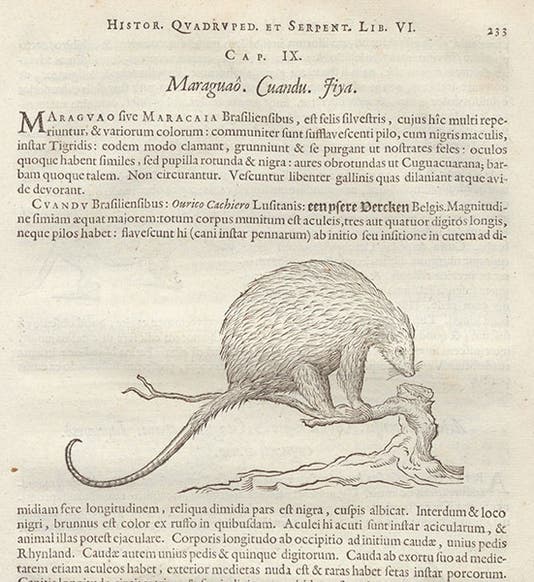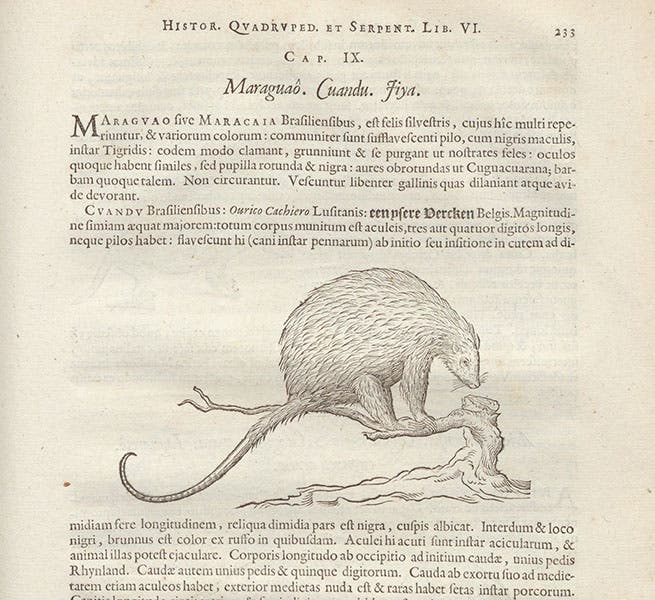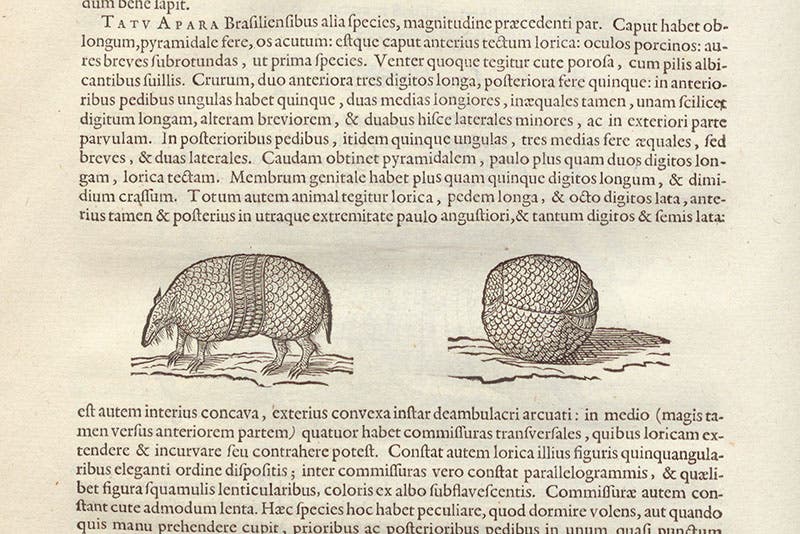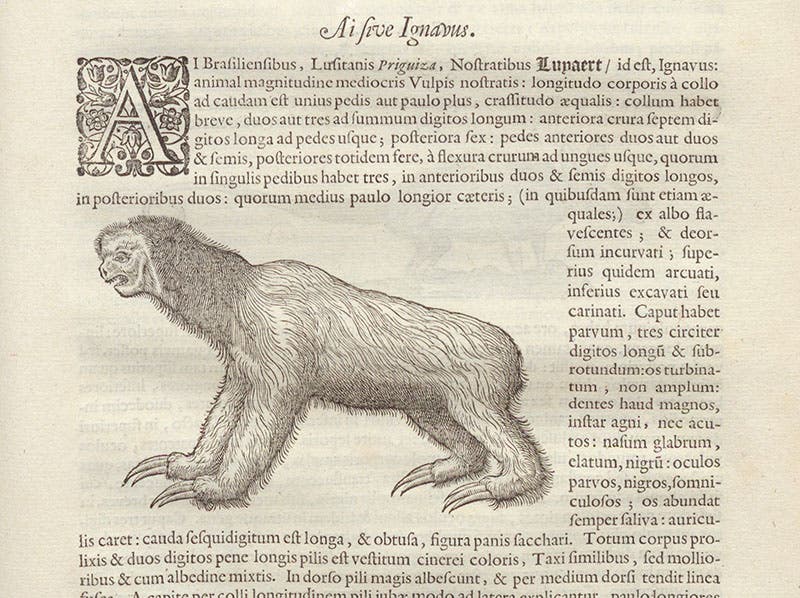Scientist of the Day - Georg Markgraf
Georg Markgraf, German astronomer and naturalist, was born Sep. 20, 1610. We know very little about his life before he accompanied a Dutch expedition to Brazil in 1638 and entered the employ of Count Johan Maurits of Nassau, who ran a sugar colony in Recife. Markgraf (also Marcgrave, Marggraf, or Marcgraf) spent much of his time making astronomical observations, but he is best known today for his studies and descriptions of the animals and plants of Brazil. He appears to have had no training as a naturalist, yet his descriptions were accurate enough that the animals and plants he observed can be easily identified at the species level. Many South American animals, such as the great anteater and the howler monkey, were first described by Markgraf. Markgraf apparently had some skill as an artist, but since Maurits retained two artists, one of whom, Albert Eckhout, was very good at drawing animals, it is not always clear who drew what. But we know that drawings of hundreds of animals and plants were made.
The other naturalist employed by Maurits was Willem Piso, who was a physician more interested in medical botany. In 1644, Maurits decided to send Markgraf to Dutch Angola in Africa. Markgraf dutifully departed, and made it to Angola, but he died soon after arrival, in 1644, only 34 years old. His notes and descriptions remained with Maurits, who turned them over to Piso for publication in a book on the natural history of Brazil. Piso hired Joannes de Laet, a Dutch stay-at-home naturalist who had already published his own book on the New World, to turn Markgraf's notes into a readable account of the mammals, reptiles, and fish of Dutch Brazil. The result was Historia naturalis Brasiliae (1648), the most thorough description of the flora and fauna of South America that had ever been published, and it would hold that prestigious spot for another century and a quarter.
We wrote our first post on Markgraf in 2016, and showed five pages from the section on mammals in the Historia naturalis Brasiliae, plus the dramatic engraved title page. Since those images were all full-page, we include details this time, and the animals are different, with one exception, from the ones shown six years ago. Our opening image is the coendou, the Brazilian or tree porcupine. For names, Markgraf usually gave the native Brazilian name first, in this case, cuandu, and then the Portuguese name, and often the Dutch name. Linnaeus would later choose from these when he came to assigning binomial names in his System naturae (1758). In this case, he chose Coendou prehensilis, since Markgraf mentioned that it uses its tail for grasping, like a monkey.
The seven-banded armadillo had long been known to Europeans, but not the three-banded version, which is the one that can roll itself up into a ball. There is a nice woodcut of the three-banded armadillo in the Historia that shows both states (second image). Markgraf called it Tatu apara.
The Brazilian opossum had also long been known to Europeans, but there were no good images in circulation. The one here is excellent (third image). Possibly the original drawing showed young emerging from the marsupial pouch. We suggest this because, when the Natural History of Brazil was republished ten years later, in 1658, it included a woodcut of the Carigueya that looks just like this one, with the addition of two young kits.
The woodcut of the Jaguar – that is the native name – is not the best, but it is a first (fourth image). I urge you instead to take a look at the text, even if you do not read Latin, to see why Markgraf was so good at his craft. You can spot words like caput and pedes and cauda, and adjectives like breves and acutissimus, and you realize that Markgraft is all business, describing the size and appearance of all the body parts, from the head down to feet. This is not how natural history was customarily done, when texts usually included stories, tales, and fables. There is none of that here.
The woodcut of the sloth included in the Historia was not that of Markgraf or Eckhout (fifth image). Apparently the original drawing was lost, so the editor, de Laet, made do with an older woodcut, one that Carolus Clusius had used in his book on exotic animals (1605). De Laet had no trouble finding it, for he had borrowed it earlier to use in his own book on the New World. The description of the sloth, however, is all Markgraf, and is excellent.
Finally, we show you the coati, which we also included in our earlier post, but now we enlarge it, to make one last point (sixth image). The watercolors and drawings that were used to make the woodcuts do not survive. But many copies were made of them in the next several decades, and quite a few of these do survive. A large portfolio of such watercolors was removed from Germany just before the war and taken to Poland, where they were rediscovered in the 1970s, and where they still reside. One of those is a crayon sketch of a coati (seventh image). It is a dead ringer for the image in the woodcut, and since it is reversed, it is probably a copy of the watercolor that was used to make the woodcut.

Coati, brown crayon on paper, Theatri, vol. 3 (Jagiellonian Library, Kraków)
In the second edition of 1658, Piso tried to deflect credit from Markgraf by removing his name everywhere and putting all the sections under his own name. All that did was make future naturalists angry at Piso; Linnaeus named an obnoxious plant with sticky seeds Pisonia in his honor. For more about the second edition of the Historia naturalis Brasiliae, see our post on Jacob Bontius, whose treatise on the East Indies was included in the reissue.
William B. Ashworth, Jr., Consultant for the History of Science, Linda Hall Library and Associate Professor emeritus, Department of History, University of Missouri-Kansas City. Comments or corrections are welcome; please direct to ashworthw@umkc.edu.












